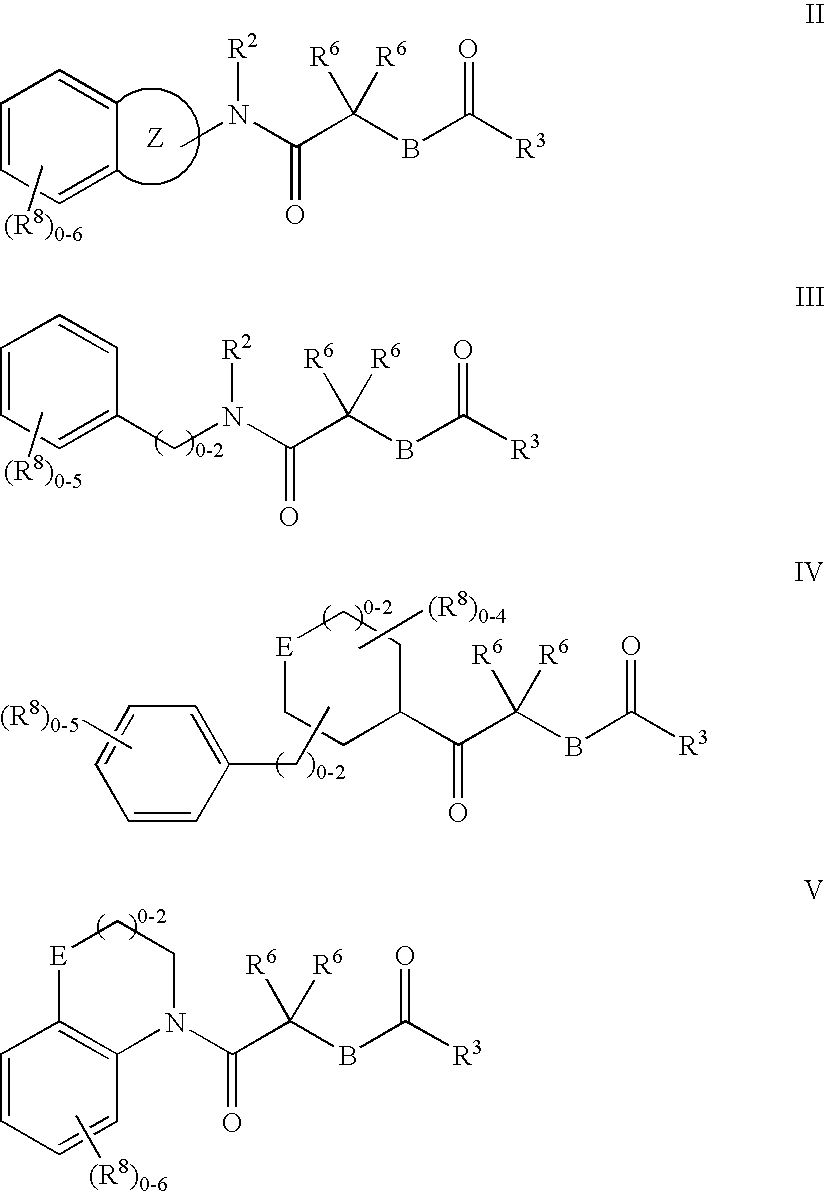Tao Kinase Modulators And Method Of Use
a technology of kinase and modulator, which is applied in the direction of drug composition, immunology disorders, cardiovascular disorders, etc., can solve problems such as cellular properties that are not suitable for use, and achieve the effect of improving the specificity of the agent used
- Summary
- Abstract
- Description
- Claims
- Application Information
AI Technical Summary
Benefits of technology
Problems solved by technology
Method used
Image
Examples
example 1
[0261]
[0262] 2-(4-Benzyloxy-phenoxy)-N-[(1,2,3,4-tetrahydro-naphthalen-1-ylcarbamoyl)-methyl]-acetamide 3. To a solution of 2-amino-N-(1,2,3,4-tetrahydro-naphthalen-1-yl)-acetamide hydrochloride 1 (67.9 mg, 0.283 mmol) in DMF (0.5 mL) and 1,2-Dichloroethane (2 mL) was added DIEA (150 μL, 0.859 mmol), HOBT (57.3 mg, 0.442 mmol), and (4-benzyloxyphenoxy)acetic acid 2 (74.0 mg, 0.287 mmol). With stirring, EDC (81.0 mg, 0.422 mmol) was added to the reaction at room temperature. The resulting slurry was stirred at room temperature for 20 hours before concentrating in vacuo and purifying via preparative HPLC. Obtained 3 as a white solid (58.4 mg, 46.7% yield). 1H NMR (CDCl3); 7.43-7.37 (mult., 4H); 7.35-7.31 (mult., 2H); 7.24-7.22 (mult., 1H); 7.19-7.16 (mult., 2H); 7.11-7.09 (mult., 1H); 6.90-6.83 (mult., 4H); 6.19-6.17 (d, 1H); 5.21-5.16 (q, 1H); 5.01 (s, 2H); 4.44 (s, 2H), 4.04-4.02 (t, 2H); 2.84-2.71 (mult., 2H); 2.07-2.01 (mult., 1H); 1.84-1.74 (mult., 3H).
[0263] 2-(4-Bromo-phenoxy)...
example 2
[0265]
[0266] 4-Pentyloxy-N-[(1,2,3,4-tetrahydro-naphthalen-1-ylcarbamoyl)-methyl]-benzamide 5. To a stirred solution of 1 (84.8 mg, 0.352 mmol) in DCM (2 mL) and DIEA (180 μL, 1.03 mmol) was added 4-pentyloxybenzoyl chloride 4 (82.0 mg, 0.362 mmol). The resulting slurry was stirred at room temperature for 14 hours before diluting with DCM (10 mL). The diluted mixture was washed with HCl (aq., 0.5M), NaHCO3 (aq., satd.) and brine. After drying over MgSO4 the solvent was removed in vacuo, yielding yellow solids which were further purified by flash chromatography (1:1 Hexanes:EtOAc). Product 5 was obtained as a white solid (63.5 mg, 45.7% yield). 1H NMR (CDCl3) 7.67-7.63 (dt, 2H); 7.24-7.22 (dd, 1H); 7.17-7.10 (dq, 2H); 7.08-7.06 (d, 1H); 7.02-7.00 (t, 1H); 6.88-6.84 (dt, 2H); 6.77-6.75 (d, 1H); 5.20-5.16 (q, 1H); 4.16-4.15 (d, 2H); 4.00-3.96 (t, 2H); 2.81-2.71 (mult., 2H); 2.07-2.01 (mult., 1H); 1.82-1.77 (mult., 5H), 1.48-1.36 (mult., 4H); 0.96-0.92 (t, 3H).
example 3
[0267]
[0268] 2-Amino-N-(2,3-dihydro-benzo[1,4]dioxin-2-ylmethyl)-terephthalamic acid methyl ester 3. To a solution of 1 (1.65 g, 10 mmol), and 2 (1.95 g, 10 mmol) in pyridine (30 mL) was added EDC (2.88 g, 15 mmol) and the mixture was stirred at room temperature for 16 h. Pyridine was removed in vacuo and the residue was dissolved in EtOAc, washed sequentially with 3M HCl, satd. NaHCO3, satd. NaCl, and then dried over Na2SO4. The solvent was removed in vacuo to give compound 3 (3.08 g, 90%) pure as a yellow solid: MS: m / z 343.20 (M+H)+; 1H NMR (CDCl3) δ 7.91 (d, 1H), 7.11 (d, 1H), 6.93-6.84 (m, 1H), 6.58 (t, 1H), 5.87 (bs, 2H), 4.42-4.36 (m, 1H), 4.34 (dd, 1H), 4.01 (dd, 1H), 3.89 (s, 3H), 3.88-3.83 (m, 1H), 3.74-3.65 (m, 1H).
[0269] 2-Amino-N4-(2.3-dihydro-benzo[1,4]dioxin-2-ylmethyl)-N1-(3-ethoxy-propyl)-terephthalamide 4. To a solution of 3 (3.08 g, 9 mmol) in THF (75 ml) at room temperature was added a solution of LiOH (647 mg in 25 ml H2O). The mixture was stirred at room tempe...
PUM
| Property | Measurement | Unit |
|---|---|---|
| Composition | aaaaa | aaaaa |
Abstract
Description
Claims
Application Information
 Login to View More
Login to View More - R&D
- Intellectual Property
- Life Sciences
- Materials
- Tech Scout
- Unparalleled Data Quality
- Higher Quality Content
- 60% Fewer Hallucinations
Browse by: Latest US Patents, China's latest patents, Technical Efficacy Thesaurus, Application Domain, Technology Topic, Popular Technical Reports.
© 2025 PatSnap. All rights reserved.Legal|Privacy policy|Modern Slavery Act Transparency Statement|Sitemap|About US| Contact US: help@patsnap.com



